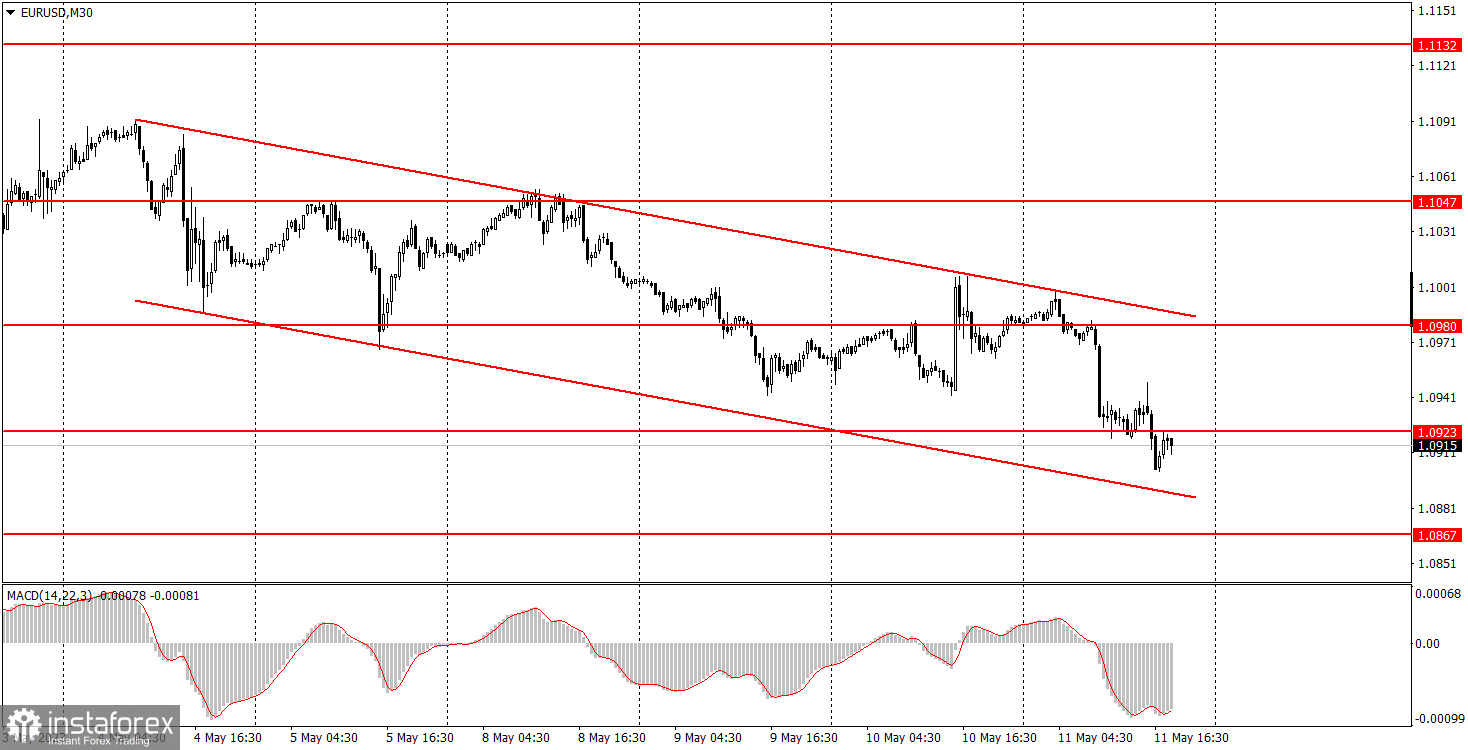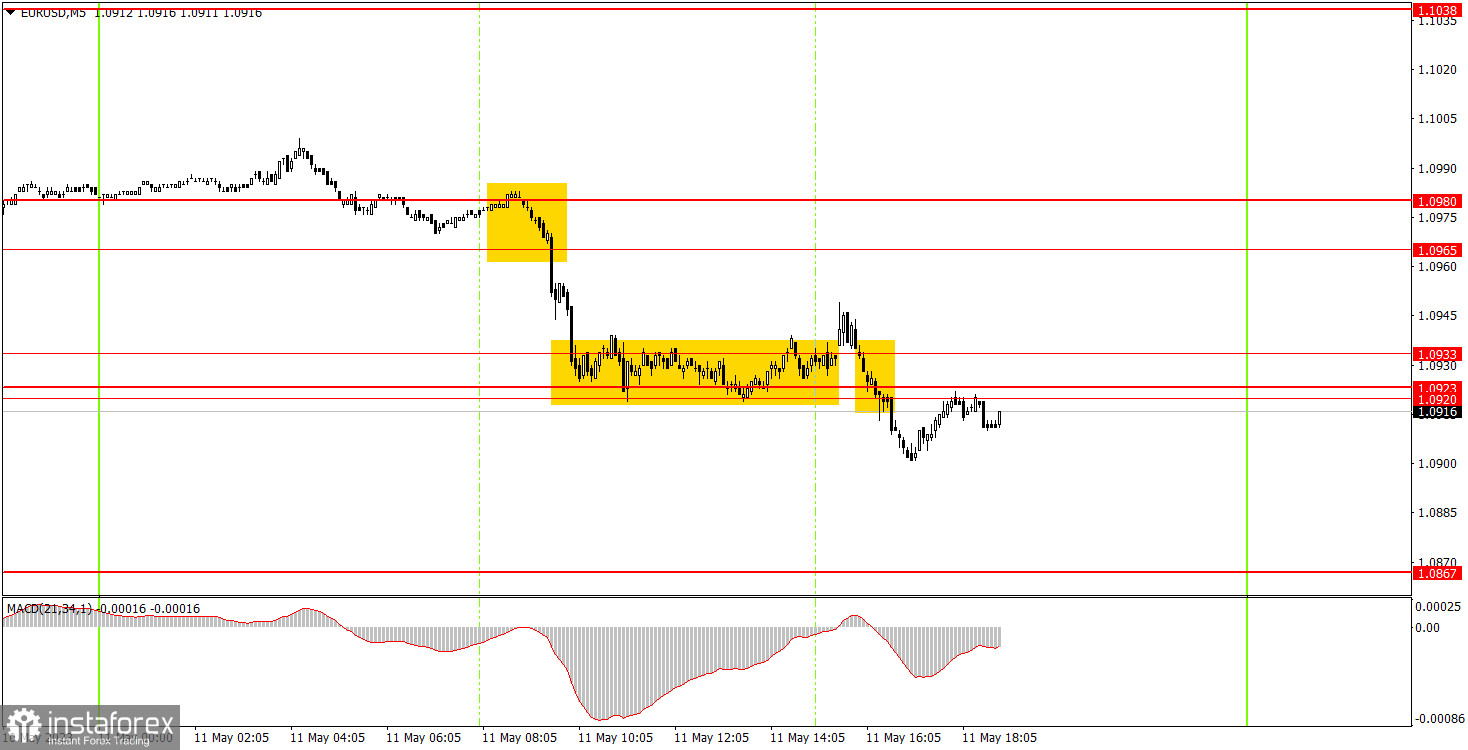Analysis of Thursday trades
EUR/USD 30M Chart

On Thursday, the EUR/USD currency pair continued moving downward. With only a few news events affecting the European and American currencies, the focus turned to concerns that the pound could potentially drive the euro up or down. Ultimately, this proved true, although the pound experienced a significantly sharper decline compared to the euro. Today, volatility reached nearly 100 points, marking a notable change.
A downward channel has emerged, supporting bearish traders for the first time in quite a while. The significant events of the day were the US Producer Price Index, which came in line with forecasts, and the unemployment claims, which were slightly worse than anticipated. Nonetheless, the dollar managed to sustain its growth. As previously noted, the dollar's rise amidst a weak macroeconomic backdrop signals the onset of a trend reversal.
In light of these factors, the American currency may continue to strengthen in the near future. Having experienced a prolonged period of decline and being heavily oversold, the European currency now lacks any growth drivers.
EUR/USD 5M Chart

On the 5M timeframe, several trading signals have been formed. After breaking the area of 1.0965-1.0980, the pair declined to 1.0920-1.0933. Sellers could profit about 10 pips on this trade. It took several hours for the formation of the next buy signal was, so it was not strong. Additionally, the Bank of England revealed the results of its monetary policy meeting, and there was a risk of the euro moving in any direction along with the pound. That is why, it was a wise decision to ignore this signal. For the same reason, traders should ignore the sell signal upon a break of 1.0920-1.0933. The volatility was high today, but there were few opportunities to make profit.
Trading plan on Friday
On the 30-minute chart, the currency pair has initiated a new stage of downward movement, which is now backed by a descending channel. This development marks the first substantial downward shift in quite some time, a logical progression from a technical perspective. The long-awaited strengthening of the dollar is finally taking place. Tomorrow, on the 5-minute chart, the target levels are: 1.0792, 1.0857-1.0867, 1.0920-1.0933, 1.0965-1.0980, 1.1038, 1.1070, 1.1132, 1.1184, and 1.1228. Once the movement progresses 15 points in the desired direction, a stop loss can be set to break-even. On Friday, the only indicator to be published in the US is the University of Michigan Consumer Sentiment. We do not anticipate a strong reaction to this report. Additionally, several Federal Reserve representatives will deliver speeches, which could be of interest, but most of these will take place in the evening. No significant or noteworthy events are expected in the European Union. Consequently, volatility may decrease once again.
The basic principles of the trading system:
1) The strength of the signal depends on the time period during which the signal was formed (a rebound or a break). The shorter this period, the stronger the signal.
2) If two or more trades were opened at some level following false signals, i.e. those signals that did not lead the price to Take Profit level or the nearest target levels, then any consequent signals near this level should be ignored.
3) During the flat trend, any currency pair may form a lot of false signals or do not produce any signals at all. In any case, the flat trend is not the best condition for trading.
4) Trades are opened in the time period between the beginning of the European session and until the middle of the American one when all deals should be closed manually.
5) We can pay attention to the MACD signals in the 30M time frame only if there is good volatility and a definite trend confirmed by a trend line or a trend channel.
6) If two key levels are too close to each other (about 5-15 pips), then this is a support or resistance area.
How to read charts:
Support and Resistance price levels can serve as targets when buying or selling. You can place Take Profit levels near them.
Red lines are channels or trend lines that display the current trend and show which direction is better to trade.
MACD indicator (14,22,3) is a histogram and a signal line showing when it is better to enter the market when they cross. This indicator is better to be used in combination with trend channels or trend lines.
Important speeches and reports that are always reflected in the economic calendars can greatly influence the movement of a currency pair. Therefore, during such events, it is recommended to trade as carefully as possible or exit the market in order to avoid a sharp price reversal against the previous movement.
Beginning traders should remember that every trade cannot be profitable. The development of a reliable strategy and money management are the key to success in trading over a long period of time.





















